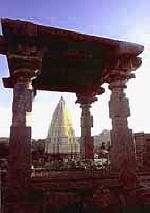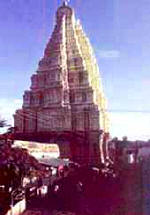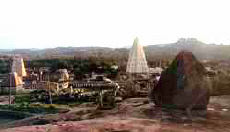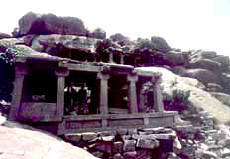Vijayanagar Wanderings
Hampi, India
By Amar Dev Dhindsa


Hampi
![]()
![]()
![]()
Have you ever wanted to be part of an Indiana Jones adventure, complete with lost city, hidden treasure, crumbling temples and screeching monkeys? Well, here is your chance. Hampi, the former capital of the fabulously rich Vijayanagar empire is probably the closest you will get to the real Indiana Jones experience. The majestic ruins of the last great Hindu empire lie scattered among the hills and on the banks of the meandering Tunga Bhadra river. Although centuries of plunder have reduced the once thriving civilisation to a crumbling granite skeleton, the place has lost none of its aura of power and beauty.
In the mid 1500’s, Portuguese travelers Paes and Nuniz described Hampi bazaar: “In this street lived many merchants and there you will find all sorts of rubies, and diamonds, and emeralds, and pearls, and seed pearls, and cloths, and every sort of thing there is on earth and that you may wish to buy.” They go on to describe some inhabitants of the city laden in all their finery: “Who is he that could tell of the costliness and the value of what each of these women carries on her person? So great is the weight of the bracelets and gold and jewels carried by them that many of them cannot support them, and women accompany them assisting them by supporting their arms.”
As you can imagine, the bazaar and the people cut quite a different image today. Although coconuts and cheap trinkets have replaced the pearls and diamonds, the present decay has not eclipsed the glory of yesterday.


Virupaksha Temple
![]()
![]()
![]()
Hampi bazaar, dominated by the huge Virupaksha Temple, is the center of the town. The town layout is along the same lines as in the times of the Krishna Deva Raya. An arrow-straight central carriageway cleaves the chaos of the bazaar and is dominated by temples at both ends. Many of the buildings still being utilised are centuries old. Solid 10 to 15 foot beams hewn from monolithic granite, locked together without any mortar have stood the test of time and the ravages of invaders. They now house local general stores, tea shops and cheap tourist eateries. Beyond the market, through the winding, back lanes numerous budget tourist hotels have sprung up to accommodate visitors from all over the world.
The ruins of the Vijayanagar empire are scattered within a 10 kilometer radius of Hampi Bazaar. To get around, the fit can walk, the less fit can cycle and the not so fit can hire an autorickshaw. To make the best use of time it’s advisable to consult a map available from Aspiration Stores in the bazaar or hire a local guide before you set out. There are thousands of things to see; every hill, rock and corner bears the mark of ancient habitation.
Every step of the way the crumbling grandeur of temples, the broken dance of a nymph, the impassive resistance of fortifications, worn sculptures of dancers, demons, gods, soldiers, elephants, snakes entice and excite your imagination.
Under the steady gaze of a hundred stone eyes you stare at walls covered in frescos: hunting scenes, dances, war, celebration and nature. They tell a hundred stories but conceal a thousand more. An aura of mystery hangs thick and heavy in the shadowed confines of these structures.
“All the outer side of the gate of the temple up to the roof is covered with copper and gilded, and on each side of the roof on the top are certain great animals that look like tigers, all gilt. As you enter this idol shrine, you perceive from pillar to pillar on which it is supported many little holes in which stand oil lamps which burn every night and they will be in number 2,500 or 3,000.” That is the famous Vitthala Temple as described by Paes. Situated on the banks of the Tunga Bhadra the temple is a 20 minute walk downstream from Hampi Bazaar.
Even today, although it is has been stripped of all but its stone, the Vitthala Temple still is an impressive sight. The delicate flowers, fearsome beasts, fluid dancers with sensuous curves and mesmerising mandalas have lost nothing of what their creators sought to communicate. In places, remnants of ancient colour still mark the walls. One can only try and guess what it must have been like in full bloom.
The pillared interior echoes with the murmur of voices and the squeak of bats suspended in the dark recesses. Eyes sweep the walls with silent reverence, hands tap the hollow pillars that were played like musical instruments. Outside, the granite chariot of the sun god proudly stands in a central courtyard. Its stone wheels could still be turned by hand till a few years ago when the authorities sealed them to prevent damage. The architecture of the Vitthala Temple strikes a fascinating balance between delicate craftsmanship and awesome presence.


Hampi Panorama
![]()
![]()
Further along, a 15 minute cycle ride from the town is the king’s royal enclosure. Today not much more than the foundation stands, but the ancient tales of the decadence and debauchery of Krishna Deva Raya brings the place alive. “Against the gate there were two circles in which there were the dancing women, richly arrayed with many jewels of gold and diamonds and many pearls. Opposite the gate there are two buildings…these buildings were all hung with rich cloths, both the walls and the ceilings, and the cloths of the walls were adorned with figures in the manner of embroidery; these buildings have two platforms one above the other, beautifully sculpted, with their sides well made and worked. On the upper platform close to the king was Christovao de Figrueiredo (another Portuguese traveler), for the king commanded that he should be put in a place as best to see the feasts and magnificence.”
Paes goes on to narrate how the king lived within this enclosure with his wives and their 12,0000 attendants! He was stunned by the opulence “to try and tell all of what I saw is hopeless, for I went along with my head so often turned from one side to the other that I was almost falling backward off my horse with my senses lost. The cost of it all is not so much to be wondered at, as there is so much money in the land, and the chiefs are so wealthy.” Today the view from the king’s dais, which still dominates the enclosure, is a sad reminder of the revelry of the past; the Queen’s bath is bone dry, the proud buildings are demolished but the tales and the aura live on.
If you aren’t thrilled by the idea of walking why don’t you take a slow boat down the Tunga Bhadra? Now these boats are not what you think they are. Paes, who in the 16th century used this same method of travel notes: “People cross to this place by boats which are round like baskets; inside they are made of cane, and outside are covered with leather; they are able to carry fifteen or twenty people. Men row them with a sort of paddle, and the boats are always turning round, as they cannot go straight like others; in all the kingdom where there are streams there are no other boats but these.”


Temple by the river
![]()
![]()
This holds true even today as a boat ride down the Tunga Bhadra is the same as it was nearly 500 years ago. A boat can be hired from the ghat near Hampi Bazaar. The price and distance would have to be negotiated. Since many of the temples are situated on the banks of the river you can see them from the boat as you slowly drift along. Pillared temples pavilions, ruined dwellings and massive granite fortifications dot the countryside. As many of the sites are very remote and inaccessible, solitude is assured.
Once you have visited the Royal enclosure, Vitthala Temple, Sugreeva’s Cave, King’s balance, Sita Konda and Chakratirth, it is time to move on to Matunga and Hematakuta Hill, Rishimukh, Anjenaya Parbat and Vali Kila; after which you can proceed to the museum, Anegondi, Malyavanta Hill. There is almost too much to see. ‘Temple fatigue’ tends to sap the energy of even the most energetic visitor. Since the temples have stood their ground for the last 400 years, it’s okay to take it easy.
There’s lots to do in the meantime, like sit in the shade of a giant mango tree sipping nimboo pani and watching the river flow.